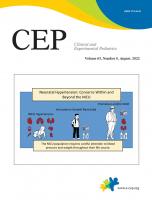Respiratory diseases, among the most common ailments in children, are usually diagnosed clinically; however, radiological confirmation is often also obtained. Chest radiography, the most widely used method, is important for diagnosing respiratory diseases. However, it has a considerably negative rate and potential for inter-observer variability [1,2]. Computed tomography, considered the radiologic gold standard for diagnosing respiratory diseases, involves considerable radiation exposure [3], sedation, and patient transfer.
Since 1991, physicians have used lung ultrasound to care for critically ill patients. Lichtenstein and Gilbert published the Bedside Lung Ultrasound in Emergency protocol in 2008 [4]. They demonstrated that artifacts and some signs occur when ultrasound waves pass through the air in the lung, providing important information about the lung conditions of critically ill patients. After this study was published, the applications of lung ultrasound have changed, and its main indications in the pediatric population have expanded. Several studies demonstrated the usefulness of lung ultrasound in pediatric pneumonia, acute bronchiolitis, and respiratory distress syndrome in neonates [5-7]. Lung ultrasound has since been established as a fundamental diagnostic examination method for pediatric respiratory diseases.
One main advantage of lung ultrasound is the decreased radiation exposure in children. This allows test reproducibility without additional irradiation. In addition, lung ultrasound offers real-time images at the bedside. Lung ultrasound is operatordependent, but the learning curve is easy as demonstrated by its low intra-interobserver variability [8]. From the start of 2020, lung ultrasound has demonstrated benefits in the first-line evaluation of patients with coronavirus disease 2019 (COVID-19). Lung ultrasound can be performed in critically ill patients without requiring transfer within the hospital, thereby increasing healthcare worker safety.
Roychowdhoury et al. [9] confirmed the usefulness of lung ultrasound in children with COVID-19. The authors noted an interstitial pattern (B-line; a hypoechoic comet-tail artifact arising from the pleural line), pleural line abnormalities such as fragmented and thickened pleural line, subpleural microconsolidation, reduced lung sliding, and consolidation in 54 pediatric COVID-19 cases. They used the lung ultrasound reaeration score in patients on mechanical ventilation to assess lung recruitment during positive end-expiratory pressure titration and predict successful weaning from mechanical ventilation. In the cases of COVID-19, isolation is necessary, which makes performing radiological examinations difficult, even simple chest radiography, owing to movement restrictions. This study demonstrated that lung ultrasound is very important for diagnosing respiratory diseases and evaluating patient condition and making treatment decisions for children with COVID-19.
However, lung ultrasound has several limitations. First, it can scan only one slice at a time; therefore, it cannot be used to evaluate the entire lung structure at a glance. Second, pathological lung diseases that do not reach the pleura, such as centrilobular nodules, cannot be identified on lung ultrasound. In addition, its use is difficult in a patient’s paravertebral area or in patients with obesity, subcutaneous emphysema, or wounds. Finally, the usefulness of lung ultrasound may be limited in children with chronic lung diseases with pathophysiological features, such as air trapping and hypoalveolarization [10,11].
The usefulness of lung ultrasound in pediatric respiratory diseases was established in several studies over the past 10 years. Knowledge of lung ultrasound is increasing, and it now represents a fundamental examination modality for pediatric respiratory diseases. Data on lung ultrasound in the pediatric population will continue to accumulate and institutional support of the health care system will increase; thus, it is expected that lung ultrasound will become the main tool for the diagnosis and evaluation of treatment responses in pediatric respiratory diseases.





 PDF Links
PDF Links PubReader
PubReader ePub Link
ePub Link PubMed
PubMed Download Citation
Download Citation


